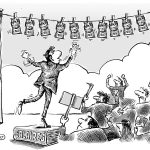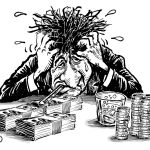Hey, buddy, got a bitcoin?
It’s hard to ignore a gain of over 20,000% in less than six years. With the Coinbase IPO, the crypto-asset universe is structuring itself.
In 2015, curious about the enthusiasm of one of my colleagues for bitcoin, I gave him a euro with which he sold me a corresponding fraction of his bitcoins, and I opened an account on Coinbase. Application among others on my iphone, it was certainly not the one I consulted the most. At least until the last months of 2017, when Bitcoin experienced its first boom, to fall back at the beginning of 2018, in a market movement resembling in all respects the South Sea bubble, the same one that made the fortune, then the ruin of the great Isaac Newton.
As ephemeral as it is, this first runaway deserved more attention in this curious active, come from the virtual world but in the foundations yet rooted in the real. Especially since a whole galaxy of new crypto assets, currencies and tokens was forming in its wake that were meeting a certain appetite, especially among the younger generations. The new surge in its price since the end of 2020, once again raises this nagging question: would bitcoin be the most fantastic scam of all time, or the harbinger of a new world monetary order – which would put end to the supposed disorders of the current one? Moreover, is it the symbol of the disqualification of the older generations – of which I am a part – by the “digital natives”? At a time when auctions of virtual works of art are successfully launched, the question deserves serious consideration.
Although its history is peppered with thefts and other scandals, bitcoin is impossible to forge.
Bitcoin was born in 2008. Built to free it from state monetary overflows and manipulations, rare and precious, decentralized and based on blockchain, this asset / protocol is guaranteed by the community of users. Its cost of transfer on the web is almost zero as far as its transactions are secure. The browsers of the “darkweb” took a quickly an interest. Likewise, its most fervent followers are recruited from countries where currencies are the most fragile and the least reliable.
Bitcoin would therefore be very similar to digital gold, responding to the same economic laws as the precious metal, in particular that of unforgeable scarcity. Bitcoin is expensive to produce (its mining consumes a lot of electricity). Although its history is peppered with thefts and other scandals, it is impossible to falsify. This is where it differs from scriptural money, which reference to gold has long since deviated, or even from other cryptoassets that do not have a predefined production ceiling. Already, bitcoins in circulation are said to be approaching a third of the total value of the world’s gold. Its rarity is therefore its strength.
It is on these common characteristics that the stock-to-flow analysis is based. According to this, only gold and silver for which the probability of a significant increase in the stock is very low, respond to the increase in demand by a certain and lasting increase in their prices. For other metals, however precious they may be, an increase in demand will lead to an adjustment in supply, ultimately limiting that of their price.
If we can now afford a Tesla with his bitcoins, no way to pay his taxes yet.
It remains to be seen whether bitcoin is indeed a currency in its own right? Recent market euphoria, driven in part by the arrival of investment heavyweights and the successful introduction of the Coinbase platform, shows that it is on its way to becoming a full-fledged reserve unit. As for payments? If we can now afford a Tesla with our bitcoins, no way to pay your taxes yet. In addition, the asset is still experiencing roller coaster volatility. The mere rumor of an imminent intervention by the US Treasury against money laundering circuits, and rumors of power cuts in the Chinese province of Xinjiang, affecting local production of bitcoin (nearly a third of the extraction would be in China), caused the price to drop by more than 20% within a few hours.
The more informed, among the technophiles, will tell you that it was to be expected. Sure of the model, the integrity and the autonomy of the system, for them, these hazards do not modify its virtues. The most skeptical, for their part, are waiting for the bubble to burst and the authorities to put it in order.
Has the “barbarian relic” found its virtual equivalent? Reasonable investment and paying off for some, act of faith for others, difficult however to ignore a gain of more than 20,000% in less than six years.
Valérie Plagnol – Apr 2021 – Published in French in www.allnews.ch – Cartoon ©Barret



